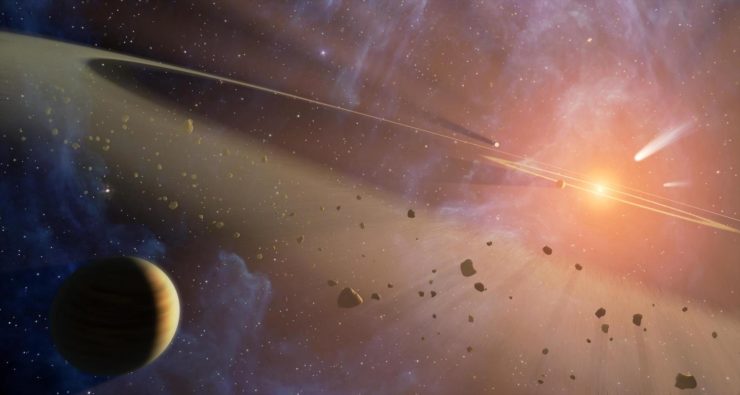If you’re anything like me, you might have enhanced your friends’ enjoyment of space adventure films by pointing out at great length and in fascinating detail just why the crowded asteroid belts backgrounds that appear in so many of these films are implausible and inaccurate! Our solar system asteroids are far from crowded. If you were to find yourself on the surface of a typical asteroid, you probably wouldn’t be able to see your closest rocky neighbour with a naked eye.
Are there situations in which these visuals wouldn’t be misleading? Can we imagine places where we could expect what appears to be an impending Kessler Syndrome on a solar scale?
At first glance Jupiter’s trojan asteroids look like they might do. For reasons gravitational, Jupiter has collected two impressive sets of asteroids in its L4 (leading) and L5 (trailing) Lagrangian points. Between them, the two populations of asteroids (one named—mostly—for Trojans, and the other named—mostly—for Greeks [even-handed treatment of both sides of the Trojan War]) may number almost half a million 2 km+ diameter asteroids, over a million 1 km+ objects, and a larger number of smaller bodies. A cloud in a limited area with millions of bodies in it sounds very promising indeed!
Unfortunately, the term “point” is somewhat misleading. The L4 and L5 communities are spread out about 2.5 AU along the orbit of Jupiter. A quick back of the envelope calculation suggests that the separation between the 1 km rocks could be comparable to the Earth-Moon distance. This is excellent news for people hoping to found vast clouds of space habitats (not only are the rocks comparatively close but also the delta vee to get from one to another is low) but less than excellent news for fans of crowded asteroid belts. A sky full of 1 km rocks separated by hundreds of thousands of kilometers is not the jam-packed vista beloved by skiffy fans.
(Obviously, for each 1 km object there are a number of smaller bodies but the decrease in average separation won’t result in angular width discernible to the human eye.)
Somewhat farther from our sun, Saturn’s rings seem offer the very thing we want. The rings are composed of a very large number of bodies, most of them somewhere between marble and shed-sized (in total, massing about the same as a small moon). The close proximity of Saturn prevents them from aggregating into a single body; basic orbital mechanics constrains them to a surprisingly thin (10–10,000 metres) plane. If you were within the rings, your field of vision would be jam-packed with small bodies of appreciable angular diameter.
Unfortunately, their apparent size would be due to close proximity, so it’s probably a good thing most of the ring particles in a given region likely have more or less the same orbit. If that weren’t the case, the experience might be akin to having swimming pools full of gravel fired at you at supersonic speeds. As it is, maybe it’s more like being in a cement mixer filled with dice.
Moving above or below the ring plane will deny you the immediate effect of being surrounded by a myriad of objects, but replace it with a no doubt stunning vista of the rings seen from just above or just before, for as long as it takes your ring crossing orbit to pass through the rings. Bring armour or hope for low relative velocities while you traverse the rings on an orbit whose parameters are definitely different from ring particles.
Another option is to find a very young stellar system, still rich in planetesimals, where giant worlds have not either absorbed them or thrown them out of the system. Not only would such a system have a more chaotic and more populous collection of small bodies, but proto-stars and very young stars offer all manner of potentially exciting behaviours not seen in boring, middle-aged suns like our own.
(This would seem to require a time machine or really good space ships. But perhaps all we need is patience enough to wait until the next time the solar system passes through a stellar nursery. A few million or billion years … no prob.)
Perhaps the easiest solution is to posit successful space industrialization combined with a lack of environmental regulation. Earth seems likely to be the main market for goods for the foreseeable future. Therefore, why not transport megatons of semi-processed raw materials to the Earth-Moon system for use in facilities in proximity to Earth? And wouldn’t compelling companies to take whatever steps are needed to prevent increasingly dense clouds of debris in said system be an onerous burden on hard-working business folk? With just a little effort, and a lot of short-sightedness, perhaps we could have entertainingly crowded skies in our own back yard. (And eventually a Kessler syndrome that would provide a one-time spectacular light show for those of us fortunate to live on the planet surface.)
In the words of Wikipedia editor TexasAndroid, prolific book reviewer and perennial Darwin Award nominee James Davis Nicoll is of “questionable notability.” His work has appeared in Publishers Weekly and Romantic Times as well as on his own websites, James Nicoll Reviews and Young People Read Old SFF(where he is assisted by editor Karen Lofstrom and web person Adrienne L. Travis). He is a four-time finalist for the Best Fan Writer Hugo Award and is surprisingly flammable.










